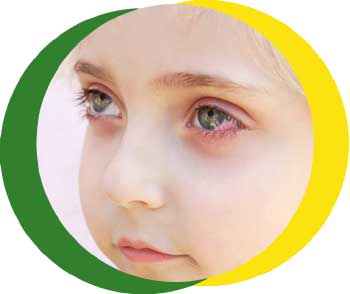Conjunctivitis

Conjunctivitis is a common eye condition that affects children, especially under 5 years of age. It can either be caused by an infection or by an allergy. Infectious conjunctivitis is contagious and may spread to other household members. Allergic conjunctivitis is more common in children with allergies such as hay fever.
If your child has conjunctivitis, they may have:
- a red or pink eye (or both eyes)
- redness behind the eyelid
- swelling of the eyelids, making them appear puffy
- excessive tears
- a yellow-green discharge from the eye which dries when your child sleeps, causing crusting around the eyelids
- a gritty feeling (like there is sand in the eye)
- itchiness of the eyes and eye rubbing
- children with allergic conjunctivitis almost always rub their eyes excessively. They may also have an itchy or runny nose and sneezing
Your child does not need to be excluded from school or childcare if they have conjunctivitis.
If your child has any of the following:
- Becomes pale, mottled and feels abnormally cold to touch
- Is going blue around the lips
- Too breathless to talk / eat or drink
- Has a fit/seizure
- Seems dehydrated (sunken eyes, drowsy or not had many wet nappies)
- Becomes extremely agitated (crying inconsolably despite distraction), confused or very lethargic (difficult to wake)
- Develops a rash that does not disappear with pressure (see the ‘Glass Test‘)
- Is under 3 months of age with a temperature of 38°C / 100.4°F or above (unless fever in the 48 hours following vaccinations and no other red or amber features)
- Is between 3-6 months of age with a temperature over 39°C
- Eye is propped out/painful to move or vision loss
You need urgent help
Go to the nearest Hospital Emergency (A&E) Department or phone 999
If your child has any of the following:
- Severe pain in eyes
- Red swollen eye
- Extreme sensitivity to light (photophobia)
- Changes in vision including flashing lights (vision can appear blurred or misted because of discharge smeared over the surface of the eye, but this will usually clear on blinking or wiping the eyes)
- Severe headache
- Persistent vomiting
- Blisters develop on the skin next to the eye
- Babies under 28 days with a red eye(s) or lots of pus from their eye(s) – note although a sticky eye due to a blocked tear duct is a very common condition in babies (and does not require medical review), this condition does not cause a red eye
- Is finding it hard to breathe
- Seems dehydrated (sunken eyes, drowsy or not had a wee or wet nappy for eight hours)
- Is becoming drowsy (excessively sleepy) or irritable (unable to settle them with toys, TV, food or picking up) – especially if they remain drowsy or irritable despite their fever coming down
- Has extreme shivering or complains of muscle pain
- Is 3-6 months of age with a temperature of 39°C / 102.2°F or above (but fever is common in babies up to 2 days after they receive vaccinations)
- Continues to have a fever of 38.0°C or above for more than 5 days
- Is getting worse or if your are worried
You need to contact a doctor or nurse today
Please ring your GP surgery or call NHS 111 – dial 111
If symptoms persist for 4 hours or more and you have not been able to speak to either a member of staff from your GP practice or to NHS 111 staff, then consider taking them to your nearest Emergency Department
If none of the above features are present
Additional advice is also available to young families for coping with crying of well babies – click here
Self care
Continue providing your child’s care at home. If you are still concerned about your child, call NHS 111 – dial 111
What should you do?
If your child has mild conjunctivitis, gentle cleaning of the eyes with cotton balls soaked in warm water may help your child feel better.
Clean in one direction only, outwards from the inside (nose side) of the eye. This prevents the other eye becoming infected if only one eye is affected. Discard the cotton ball each time to prevent reinfection.
Do not try to clean inside the eyelids as this may cause damage to the inside of the eye. Lubricating eye drops such as ‘artificial tears’ may give some relief.
Although infective conjunctivitis is contagious, the likelihood of it spreading is not high unless there is close contact with others. To reduce the risk of spread, they should wash their hands regularly (especially after rubbing their eyes) and avoid sharing towels, pillows, eye drops, make-up with others until the discharge from their eyes has cleared. Most children with conjunctivitis do not need treatment with oral antibiotics or antibiotic eye drops, irrespective of whether their infection is caused by a virus or bacteria.
Sore, inflamed and itchy eyes due to allergic conjunctivitis may be helped by antihistamines. Speak to pharmacist about antihistamine use for your child.
How long will your child’s symptoms last?
Most conjunctivitis in children (bacterial or viral) is mild. It usually clears within 7 to 10 days without antibiotics.
Where should you seek help?
- If it is non-urgent, speak to your local pharmacist or health visitor.
- If your child has any of the above features, urgently see your GP. For an urgent out-of-hours GP appointment, call NHS 111.
- You should only call 999 or go your nearest A&E department in critical or life threatening situations.

